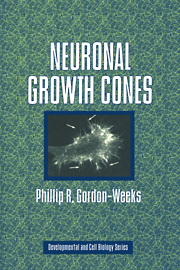1 - Introduction
Published online by Cambridge University Press: 29 August 2009
Summary
What are growth cones?
Of all animal cells, neurons have the most diverse and remarkable shapes. They vary in appearance from the simple, unipolar cells of invertebrate ganglia to the highly complex pyramidal cells of the human cerebral cortex with their profusion of processes and thousands of synapses. The basis for this diversity of shape is the ability of developing neurons to produce long and branching cellular processess, of which two distinct kinds are recognised: axons and dendrites. In mature neurons, axons convey action potentials away from the neuronal cell body, or soma, to the axon terminals, whereas dendrites transmit information toward the soma. Primary sensory neurons form an exception to this general rule since they have an axon which conveys action potentials towards the cell body. Axons and dendrites, collectively referred to as neurites when they are growing, are necessary for neurons to carry out their primary function, in which they have no equal, that of intercellular communication. In the central nervous system (brain and spinal cord), neurons usually communicate with each other, whereas in the peripheral nervous system they also communicate with a variety of effector cells such as muscle and secretory cells. In the adult, the distance over which the neuron must sustain its cellular processes to communicate with another cell may be considerable; it is many metres in the case of pyramidal motoneurons in large mammals such as the whale.
- Type
- Chapter
- Information
- Neuronal Growth Cones , pp. 1 - 29Publisher: Cambridge University PressPrint publication year: 2000



